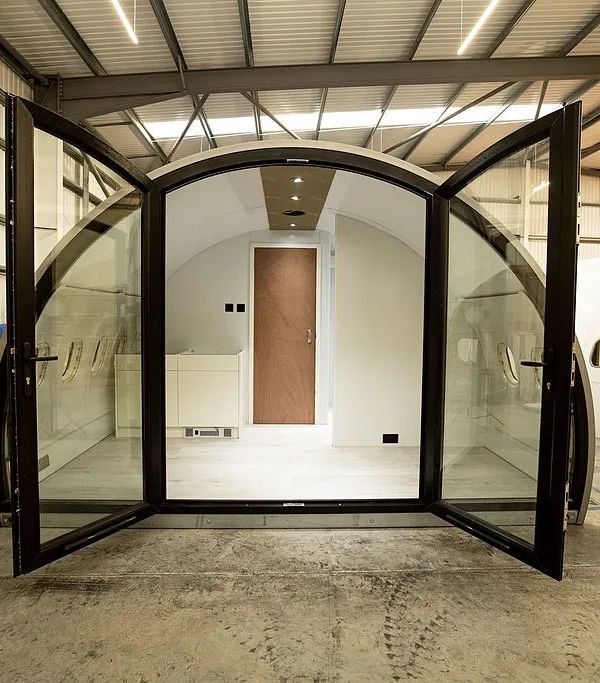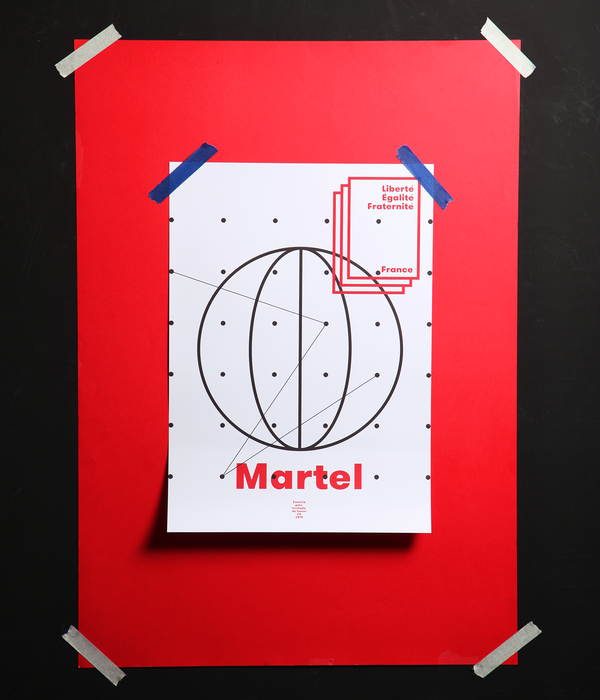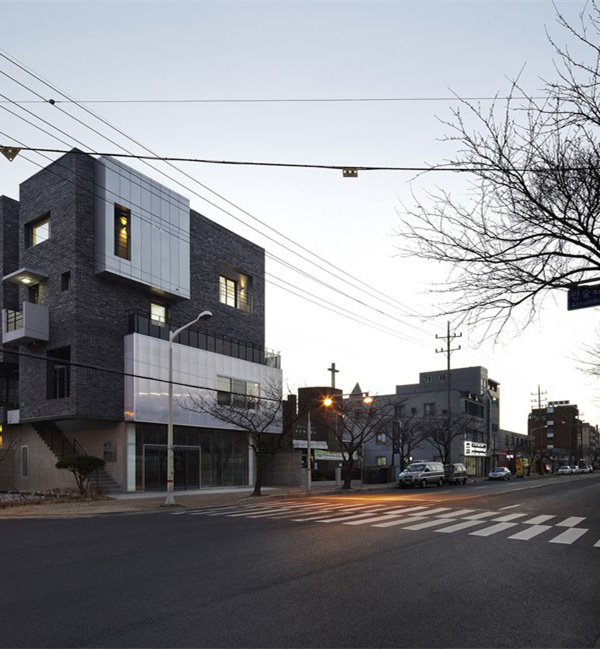在比利时举办的第85届利布拉蒙农业博览会之际,一个名为《Welcome Pavilion》的独特展馆受到了大众的欢迎。作为森林业和木材交易的图腾,首次采用了冷弯CLT板作为结构材料,由建筑事务所Art & Build和设计公司Saïse共同设计,与结构事务所Ney & Partners/WOW 和生产商Laminated Timber Solutions协作完成。
Commissioned for the 85th edition of the Libramont Fair in Belgium, the “Welcome Pavilion” was conceived by Art & Build Architects and Saïse Design as a totem for both forestry and timber trades, featuring the first structural use of cold-bent CLT panels. The iconic pavilion, open to the public for the duration of the show, is the fruit of a close collaboration between Art & Build architects, Saïse design, and structural engineers Ney & Partners/WOW. Laminated Timber Solutions completed the team as specialist timber contractors responsible for manufacturing the components.
▼项目外观 external view of the project ©Ney&Partners
今年的博览会活动主题是 “谁将建造我们未来的城市?”,作为回应,团队探索了如何利用日益成熟的数字技术,与原始传统的森林业相碰撞产生出的建筑潜力。Art & Build建筑事务所的CEO David Roulin表示,« Nautile Sylvestre »被竖立在活动场地的核心,这是“木建筑作为传统混凝土建筑的良性替代品”的有力且令人信服的展示。
The theme of this year’s Fair was “Who will build the cities of tomorrow?”, to which the team responded with a design that explores and expresses the potential of digital tools when applied to raw, conventional forestry products. The Nautile Sylvestre was erected as the centrepiece of the DemoForest site in neighbouring Bertrix, a powerful and convincing demonstration of “wood construction as a virtuous alternative to traditional construction” according to David Roulin, CEO of Art & Build Architects.
▼装置与人的互动,interact between the installation and people ©up/lower left: Jean-Pirre Ruelle, lower right: Saise Design
基于对晶格铰链弯曲的初步研究(一种被数字工具重新唤起的传统工艺),设计团队希望以基于6厘米厚的CLT面板的结构性能来实现更大尺度的作品。预制结构的仿生灵感来自香蕉树干非凡的结构效率,它由16个面板组成,以两个互锁的螺旋形式排列,通过楼梯踏板在结构上相连。展馆的跨度为8米,高度为5.4米,而这正是一座潜在的超级建筑的一段横截,使游客可以登高俯瞰整个集市和森林的全景。在材料方面,对触觉和嗅觉的重唤,以及木材的弯曲层之间的光影效果增强了波动和节奏感。 Ney&Partners / WOW的工程师Benoit Hargot说: “开口的大小是根据曲率半径确定的,曲率半径趋向于向结构中心减小,从而形成变化的图案。” 许多参观者将展馆体验描述为 “灵性的” 。
Based on preliminary research on lattice hinge bending (a traditional process brought up to date with the help of digital tools), the design team scaled up their theoretical models in order to test the structural properties of 6 cm thick CLT panels. Biomimetically inspired by the extraordinary structural efficiency of the banana trunk, the prefabricated structure consists of 16 panels arranged in the form of two interlocking spirals linked structurally by stair treads. With a span of 8 metres and a height of 5.4 metres, the pavilion’s dimensions represent the truncated section of a potential superstructure, allowing visitors to ascend to a panoramic viewpoint overlooking the surrounding fairgrounds and forest. A truly introspective demonstration of material sensuality, the design appeals to the tactile and olfactory senses, with plays of light between the curved strata of the structural timber enhancing the fluctuation and rhythm of the sun’s rays as they penetrate the notches in the structure. “The size of the notches is parametrically defined according to the radius of curvature that tends to decrease towards the centre of the structure, creating a variable pattern,” says Benoit Hargot, engineer at Ney & Partners/WOW. Many visitors have described the pavilion experience as “spiritual”.
▼结构分析,structural analysis ©ArtBuild
▼木板几何分析,geometry of the panels ©ArtBuild
▼剖面图,section
对于展会组织者来说,新场馆最重要的特征之一是其可以被拆卸后运输到其他地方组装,成为了一种可以移动的工具。与传统的弯曲工艺相比,圆形锯切的平行槽口既节省世界又节省能源,让构件能够以大型平板包装的方式运输。弯曲和组装均在现场由当地工人手动完成,仅需花费四天时间。
For the organizers of the Libramont Fair, one of the most important features of the new pavilion is its ability to be dismantled, transported and reassembled elsewhere, becoming a nomadic, demonstrative tool. The circular sawed parallel notches offer both time and energy savings when compared to traditional bending processes, making it possible to flat pack large-format components for transport. Bending and assembly was carried out manually on site by local apprentices in just four days.
▼安装过程,assemble process ©ArtBuild
▼平行槽口细部 details of the paralleled notches ©ArtBuild
展馆中隐藏的由双螺旋楼梯生成的巨大的空间,足有5.4米高, 用作储存和展示空间。这座木制的“教堂”可通过枢轴铰链上的两个预应力门进入,该铰链的无缝地嵌入结构中。
A hidden treasure to be discovered within the pavilion, the twin-revolution staircases generate a vertiginous negative interstitial space with a ceiling height of 5.4 metres, used both as storage space and as an exhibition gallery. This wooden “cathedral” can be accessed from both sides of the structure by means of two prestressed doors on pivot hinges whose curvature fits seamlessly into the structure.
▼双旋转楼梯 twin-revolution staircases ©ArtBuild
▼存储和展览空间 storage space and exhibition gallery ©ArtBuild
▼楼梯与墙面节点细部,details of the joints between the staircase and the wall ©ArtBuild
对于Art&Build建筑事务所的项目总监Kévin Guidoux来说,“该项目优化了所有的材料与细节,平面与空间,这意味着细致到木材的每一条纤维都被完美的应用在结构,功能和感官品质”
For Kévin Guidoux, Art & Build’s project director, “All the materials used – the details, surfaces and the spaces that they generate – are optimized to work together, meaning that each wooden fibre is purposed for its structural, programmatic and sensorial qualities.”
▼轴测图及材料分析,axonometric and material analysis Art&Build_2D_中文
{{item.text_origin}}












